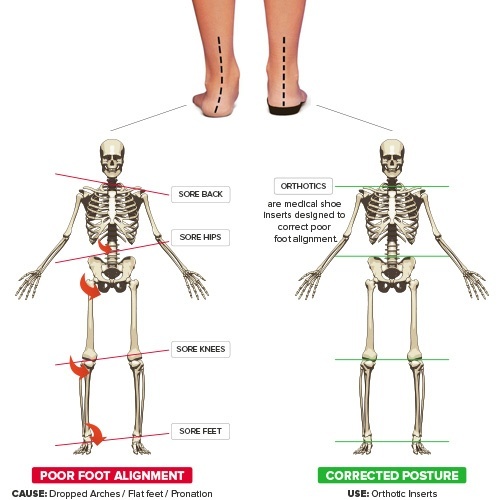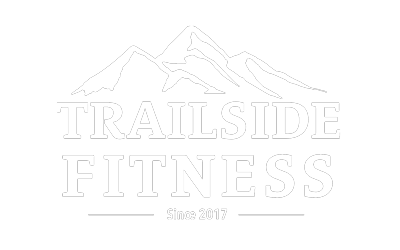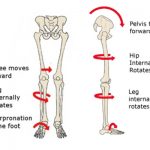Overpronation is when the foot over flattens during walking. During a hike, this over flattening can cause the joints to take on more rotation force which can lead to common aches and pains in the ankles, knees, and hips. This post will look at causes and solutions for hikers with overpronation.
As a physical therapist assistant for the past five years as well as a personal trainer, I know that a lot of problems can start in the feet.
Where Does It Hurt?
The survey results were found at the website The Trek, which does an annual survey for Appalachian Trail hikers. You should check it out, it’s pretty in-depth; these results are from 2017. The biggest age range in the survey was age 21-30, which is not that surprising until you see the percentage of hikers with common joint problems that are typically not present until later in life.
According to the survey, hikers reported pain in the following areas:
- 63% Feet (I’m putting overpronation in this category)
- 58% Knee problems
- 21% Back Pain
- 18% Hip Pain
- 12% Headaches (generally posture related, but could also be dehydration which was reported by 37%)

Overpronation is an excessive arch drop while walking or even standing. There is naturally some pronation that occurs with walking; this is just a more extreme version of that. The reasons for overpronation are varied but generally involve weak foot muscles or weak hip muscles.
The implications from this fallen arch will move up the leg and affect the rest of your body.
Check out our FREE Download here!
How Overpronation Effects The Body
To begin, the body has a series of mobile and stable joints in alternating fashion. Take a  look at the image to the left to get an idea of how this looks. When the body is missing motion that a mobile joint provides, the body will try to find that motion from a nearby stable joint. That’s what neighbors are for right?
look at the image to the left to get an idea of how this looks. When the body is missing motion that a mobile joint provides, the body will try to find that motion from a nearby stable joint. That’s what neighbors are for right?
Unfortunately, the body’s attempt to find the motion will not serve you well long-term.
For example, if you are missing ankle motion, your body will try to find that missing motion from the foot or the knee. Since these are considered stable joints, they don’t have much to offer for motion and that’s where the pain and discomfort start to creep in.
With overpronation, the body has too much motion creating ramifications for the knee, hip, and low back and even up into the shoulders. This can, for some people, be the source of their headaches!
 What happens at the ankle, happens at the hip.
What happens at the ankle, happens at the hip.
Let’s follow the fallen arch upwards. See how the arch collapsing creates knee movement inward? The opposite end of the femur from the knee is the hip. The ankle rolls inward, as does the hip.
Since the hip is now missing some motion and being asked for a more supportive/stable role, the low back is going to be asked to provide motion. Your lumbar spine disagrees with this notion of motion, and low back pain can now take root.
What Does That Mean?
This loss of motion, even a few degrees or millimeters, can create a muscle imbalance which can create even further issues. It can create knee pain, a pinching feeling in the front of your hip, low back pain, mid back tightness, and headaches.
You’ll note that the right side of the image above shows a “corrected posture” where the overpronation has been corrected with the use of an orthotic, like Superfeet. It can really be that simple! Of course, you’d be better suited by building foot and hip strenght as a long term solution.
In a more dramatic image, you can see again how that arch affects the knee and hip.
The knee responds to overpronation by hyperextending (going slightly beyond straight) and placing undue strain on the meniscus.
The hip responds by decreasing its full range of motion to provide stability and that can cause significant problems down the road (generally speaking, decades). Joints need a full range of motion in order to stay lubricated and healthy. If left unchecked, it can result in arthritis and joint degeneration, which is what causes people to get their knees and hips replaced.
Okay, Now What?
There are a few common courses to help address this: orthotics, better footwear choices and exercise. Being able to strengthen the foot is best long-term, as the orthotic can act as a supportive crutch and not actually allow the foot to get stronger.
Selecting a better shoe will also be really helpful. Altra’s seem to be the default shoe for hikers, but they don’t really offer much support. Hikers like them because they are cushy and offer a wide toe box. Some of the problems with Altra’s is the lack of arch support and that they are designed for runners, not hikers. These are trail runnig shoes and not designed for hikers who will be carrying a 35lb pack!
Exercises
Sometimes with overpronation, the muscles simply tire out and can no longer help support the arch. A simple exercise like this can help to build the main muscle that supports the arch, Abductor Hallucis. When weak, this muscle cannot maintain the arch shape, feeding into the overpronation.
Short Foot
For this exercise, contract the muscles to pull the arch straight up. I like to imagine that I am shortening my foot by trying to bring my big toe and my heel together.
[wpvideo Ej8qXZHm ]
Perform 3 sets of 8-10 reps, holding for 7 seconds each repetition.
Slanted Arch Hold
This alternate arch builder exercise uses a slant board and may be easier than the above exercise to start out. It can be performed for repititions or just holds – both are effective.
[wpvideo xLChVDOY]
[wpvideo L5XnDPMg]
Work up to 30 second holds, repeat 4 times. Alternatively, work up to 4 sets of 20 raises.
Why rely on an insole when a simple exercise will benefit you in the long run?
If you are experiencing discomfort in your ankles, knees, hips or low back with your training hikes or while out on your thru-hike, remember that it may be caused by your feet! Start the exercise to help strengthen your foot, walk around in your yard, park or beach and home barefoot more often.
By doing your shakedown hikes, you will be able to test out your footwear. Be critical in how they feel! If they are uncomfortable in the slightest, make adjustments. In addition to your training hikes, be sure to physically train for your hike too!
Be sure to like our Facebook page and follow us on Instagram and Twitter!
You can reach me info@trailsidefitness.com with any injury issues, past or present that you feel will impact your hike. Training questions are also welcome – I am happy to help!



Recent Comments